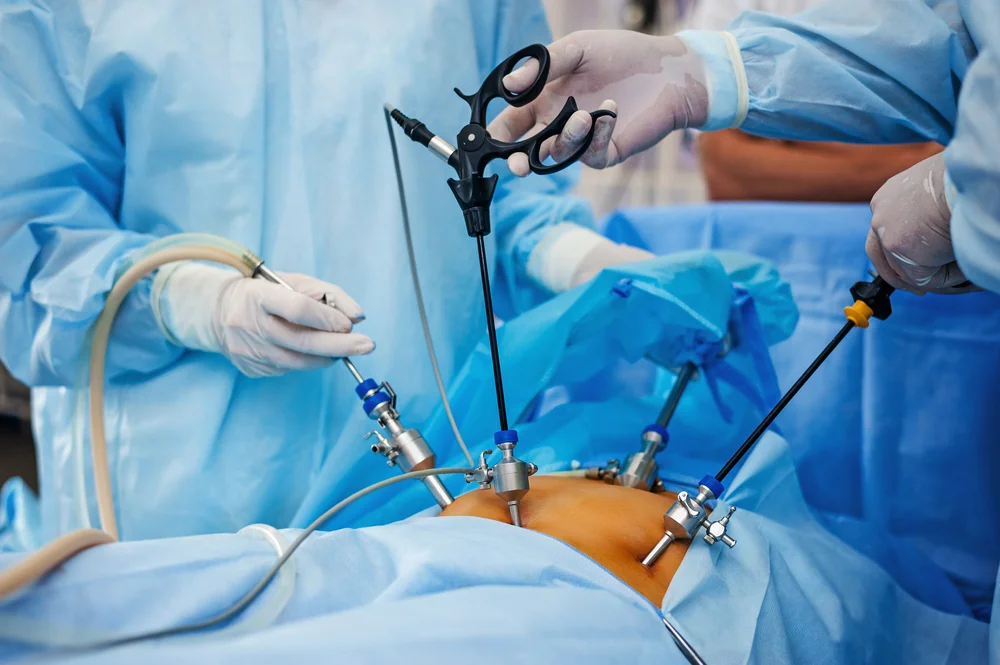Laparoscopic surgery, also known as minimally invasive surgery (MIS) or keyhole surgery, is a modern surgical technique that involves making small incisions (typically less than an inch) rather than large cuts to access the organs inside the abdomen or pelvic region. The surgery is performed using a laparoscope, a thin, flexible tube with a camera and light at the end, which allows the surgeon to view the internal area on a monitor.

How Laparoscopic Surgery Works
- Preparation: The patient is usually placed under general anesthesia to ensure they are unconscious and pain-free during the procedure.
- Small Incisions: The surgeon makes several small incisions in the abdominal wall (usually between 0.5 to 1.5 cm each). These incisions are typically located in the belly button and/or other areas depending on the procedure.
- Insertion of Instruments:
- Laparoscope: A long, thin tube with a light and camera is inserted into one of the incisions. The camera sends real-time images to a video monitor, which the surgeon uses as a guide.
- Other Surgical Instruments: Other thin instruments are inserted through the remaining incisions to perform the procedure. These instruments may include forceps, scissors, suturing devices, and cautery tools (used to stop bleeding).
- Gas Insufflation: A gas (usually carbon dioxide) is introduced into the abdominal cavity to inflate it slightly, creating more space for the surgeon to view the organs and operate more easily.
- Surgical Procedure: Using the laparoscope and specialized tools, the surgeon performs the necessary operation while watching the procedure on the monitor. This might involve cutting, cauterizing, removing tissue, or repairing damage, depending on the condition being treated.
- Completion: Once the surgery is finished, the instruments are removed, the gas is released from the abdomen, and the incisions are closed, usually with stitches or staples.
Types of Laparoscopic Surgery
Laparoscopic surgery can be performed for a variety of conditions, especially in the abdominal and pelvic regions. Here are some common types of laparoscopic surgeries:
1. Laparoscopic Cholecystectomy
- Purpose: Removal of the gallbladder, often due to gallstones or gallbladder disease.
- Procedure: The surgeon removes the gallbladder via small incisions, using the laparoscope for guidance. This is one of the most common laparoscopic procedures.
2. Laparoscopic Appendectomy
- Purpose: Removal of the appendix, typically performed in the case of appendicitis.
- Procedure: The appendix is removed through small incisions in the lower abdomen.
3. Laparoscopic Hernia Repair
- Purpose: Repairing a hernia, such as an inguinal or umbilical hernia.
- Procedure: The surgeon uses laparoscopic instruments to push the protruding tissue back into place and reinforce the abdominal wall with mesh.
4. Laparoscopic Gastric Bypass (Bariatric Surgery)
- Purpose: Weight-loss surgery that reduces the size of the stomach and changes the way food moves through the digestive system.
- Procedure: The surgeon makes small incisions to perform the surgery, which helps patients lose weight by limiting the amount of food they can eat and the absorption of calories.
5. Laparoscopic Hysterectomy
- Purpose: Removal of the uterus, commonly performed for conditions like fibroids, endometriosis, or uterine cancer.
- Procedure: The uterus is removed through small abdominal incisions, allowing for quicker recovery compared to traditional open surgery.
6. Laparoscopic Ovarian Cyst Removal
- Purpose: Removal of ovarian cysts, which are fluid-filled sacs that form on the ovaries.
- Procedure: The cyst is removed through small incisions, which minimizes recovery time compared to larger, traditional cuts.
7. Laparoscopic Colorectal Surgery
- Purpose: Treatment of conditions affecting the colon or rectum, such as colon cancer, inflammatory bowel disease (IBD), or diverticulitis.
- Procedure: Surgeons may remove tumors, repair parts of the bowel, or address other colorectal issues using laparoscopy.
8. Laparoscopic Surgery for Obesity (Bariatric Surgery)
- Purpose: Treatment for severe obesity through various techniques, such as laparoscopic sleeve gastrectomy, gastric bypass, or gastric banding.
- Procedure: The goal is to reduce the stomach size or bypass parts of the digestive system to help patients lose weight and improve overall health.
9. Laparoscopic Liver Surgery
- Purpose: Removal or biopsy of liver tumors, treatment of liver disease, or managing conditions such as liver cancer or cystic disease.
- Procedure: Surgeons use laparoscopy to access the liver and remove the affected areas or take tissue samples for biopsy.
Advantages of Laparoscopic Surgery
- Smaller Incisions: The incisions made are much smaller compared to traditional open surgery, often resulting in smaller scars and less tissue damage.
- Reduced Pain: Because laparoscopic surgery is less invasive, patients typically experience less postoperative pain, leading to a lower need for pain medications.
- Faster Recovery: Patients usually recover more quickly than with traditional surgery, often being able to go home the same day or the next day. Many people return to normal activities within a few weeks.
- Lower Risk of Infection: The smaller incisions reduce the risk of infection, as there is less exposure of internal tissues to external elements.
- Less Blood Loss: Since laparoscopic surgery is minimally invasive, it often leads to less bleeding during and after the procedure.
- Shorter Hospital Stay: Patients usually have a shorter hospital stay, which reduces the overall cost of the surgery.
- Improved Precision: The use of a camera and video monitor provides the surgeon with a clearer view of the organs, allowing for more precise movements and less risk of damage to surrounding tissues.
Limitations and Risks of Laparoscopic Surgery
- Limited Access: Although laparoscopic surgery is effective, some procedures may require open surgery if the laparoscopic approach proves too difficult or if complications arise during the operation.
- Specialized Training: Laparoscopic surgery requires specialized training and experience, so not all surgeons may be skilled in these techniques. Surgeons must practice and develop expertise to perform these procedures effectively.
- Risk of Complications: As with any surgery, there are risks, including bleeding, infection, injury to surrounding organs, or adverse reactions to anesthesia. However, these risks are generally lower in laparoscopic procedures than in traditional open surgeries.
- Longer Procedure Time: Laparoscopic surgeries can sometimes take longer than open surgery, as the surgeon must work through small incisions and use specialized instruments.
- Cost: Although laparoscopic surgery can reduce hospital stays and recovery time, the initial costs of the equipment and the surgeon’s training can make the procedure more expensive in some cases.
